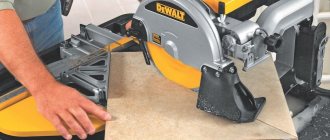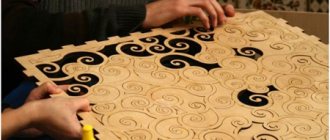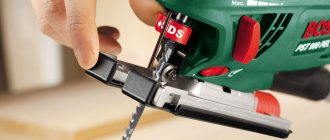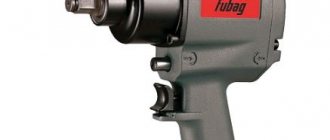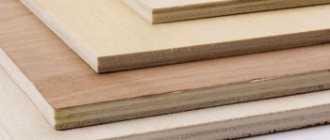Rating of the best electric jigsaws
| Place | Model | ||
| 1. | Makita 4329 450 W | Prices | Review |
| 2. | BOSCH PST 700 E 500 W | Prices | Review |
| 3. | BISON L-400 400 W | Prices | Review |
| 4. | Interskol MP-85/700E 700 W | Prices | Review |
| 5. | VORTEX LE-65 650 W | Prices | Review |
Cutting technology
They begin sawing after securing the workpiece and applying markings. To do this, you need to turn on the jigsaw, set the maximum speed level and adjust the pendulum stroke by setting it to number 1.
You need to bring the file to the marking line, press the side of the platform against the guide and start working. When moving the jigsaw forward, you need to monitor the location of the platform. Do not deviate from the guide. When there are a few centimeters left to the end of the canvas, you need to carefully hold the free edge, avoiding breaking. At this point the process can be considered complete. To prevent the cut from turning out crooked, it is worth remembering a number of nuances:
- During operation, do not press too hard on the electric jigsaw, otherwise the file will break;
- when cutting a steel sheet, you need to choose a tool with maximum power and work at high speed - when heated, the steel softens and becomes more pliable;
- When processing plastic, laminate, organic glass or stainless steel, it is necessary to provide additional cooling for the file and periodically take breaks so that the tool has time to cool down;
- to prevent the plastic from melting during processing, it is necessary to set the minimum speed with a frequency of 1000 rpm;
- the figured cut will be smooth if you choose a narrow file with small teeth;
- After finishing the work, the electrical device should be cleaned of sawdust and placed in a special case.
How to work with a jigsaw: features and rules
The electric jigsaw cuts unevenly. There is no need to rush and use force here. It is better to cut slowly and press the tool lightly against the material.
When working with a jigsaw, you should follow the rules
There is a small educational program on how to cut with a jigsaw exactly in a straight line, and so that the blade does not slip:
- While sawing you need to keep an eye on the file . As soon as it becomes a little dull, it should be replaced. When the file is dull, it moves away and chips appear.
- It is necessary to ensure that the file does not overheat , otherwise the teeth will quickly become unusable.
- Each type of file is designed for a specific material .
- The power of a tool directly affects its performance . The higher the power, the more different materials it can cut.
- Dense materials (countertops, laminate) can be sawed with a file with large teeth . Fiberboard and plywood are easy to cut with a fine-tooth saw .
- For a more even cut, you can use appropriate devices - stops or guide rails .
Any material can serve as a guide. The main thing is that it has a smooth edge and the ability to correctly align and fix it.
Prevention of breakdowns
Preventative measures always extend the life of any tool, including jigsaws. To begin work, unscrew the screws and open the housing. Using alcohol and a cotton cloth, it is necessary to clean all components from old grease. Then new lubricant is applied to the required points (in accordance with the recommendations specified in the instruction manual)
It is very important to process the dynamic parts of the unit (current, gearbox)
There are also a number of preventive measures:
- use only “original” parts;
- produce fabrics by 70 percent and then change them;
- use only those canvases that correspond to the nature of the work;
- during work, you should not “strain” yourself with excessive mechanical loads;
- Clean the instrument from accumulated dust at least once a week;
- use WD-40 lubricant;
- use a vacuum cleaner for cleaning;
- do not hit or drop the tool - this often leads to damage to the supporting rod;
- Do not tighten the file in the mount too much;
- for materials that are too dense, there are special devices that must be used;
- each material has its own optimal operating mode (speed, angle of inclination, etc.);
- the base of the support roller must be treated with a special technical lubricant at least once a week;
- You should actively use technical brushes to process the tool after finishing work;
- You should always monitor the ventilation grille of the instrument and clean it of mechanical microparticles.
https://www.youtube.com/video/cFlc5bAYwTM
You will learn how to repair a jigsaw with your own hands from the video below.
How to make a perfect cut with a jigsaw
To get a correct, beautiful and straight cut, you need to follow the following recommendations.
Selection of cutting blade
For shaped and fine work, it is better to take thin files . If you need to make a complex pattern, you need to use files with 2 cutting edges . The leading edge guides the main cut, and the rear edge makes the saw maneuverable, preventing scraps.
Fastening material
Many people neglect such a simple rule as fastening the material. It's one thing when the structure itself is bulky . There is no need to pin anything here. But if you need to cut, for example, a sheet of plywood, you can’t do without fasteners. The material is light and without fixation you can ruin everything.
Blade holder faults
Many modern jigsaws are equipped with bells and whistles, which are their weak points. For example, some models often require repair of the saw blade mount due to the presence of such functions as:
- A quick clamp
that does everything for the tool owner: just move the lever, place the blade and work. Over time, the structure becomes loose and fastening parts become unusable. Unfortunately, most of these clamps cannot be repaired; they must be completely replaced. - Lightweight screw fastening
is a real problem for owners of cheap and mid-price tools. The rod attachment, made of weak alloys, has low strength, breaks, and the bolts break the seats. Repair consists only in the handicraft production of the appropriate product from durable steel, since each line of cheap tools often has its own saw blade holder configuration.
If the jigsaw has a classic screw fastening of the file, then repairing it will not be difficult. This is a durable and time-tested design; you can use bolts for a Phillips screwdriver or a wrench. The clamping blocks are standard; finding a replacement for an extremely worn part is not difficult. There is a problem with thread wear, but in this case a new one can be cut.
Why can a jigsaw cut crookedly?
Not everyone knows how to saw off a workpiece smoothly with a jigsaw. The tool is light and without sufficient skill, the entire cut can go crooked .
Why does this happen:
- No experience with the tool.
- Saw blade with defects.
- Play in the guide roller. There may be 2 reasons: wear of the internal part and failure of the mounting holes.
- Rod wear. With such a malfunction, a large backlash occurs.
These are the most basic faults. There may be others, so you need to take all points into account.
Various methods are used to obtain an accurate cut.
Gearbox repair and how to lubricate it
The task of the jigsaw gearbox is to convert the rotational motion from the electric motor into reciprocating motion and transfer it to the rod with the saw. At the same time, different models of different brands use completely different technical solutions.
These can be miniature crankshafts (similar to the crankshaft of a car or the wheel drive of a steam locomotive), mechanisms with sliders, gears with an eccentric hole or spike, etc.
What to do if you have problems with accuracy
Below we will look at how to cut smoothly with a jigsaw and get an accurate cut.
Sawing with a saw table
Often you have to cut out round or oval elements . You can't do without a saw table. On the underside of the tabletop you need to secure the jigsaw with the file facing upwards. Secure the start and stop buttons to the side. All that remains is to move the material in the right direction.
Sawing with a guide bar
The tire looks like a long ruler 1.3-1.5 meters . A groove is made in it and the jigsaw moves along it. The file must be adjusted along the cutting line, and the tire must be secured with a clamp. When sawing, the tool should be guided strictly along the tire.
Fastening material
In order for the cutting line to be smooth, the working surface must be as stable, rigid and durable as possible. When working at home, this can be an ordinary table with reliable legs and a flat tabletop.
The board is fixed to the surface using clamps secured on both sides with moderate force. The sheet to be processed must be positioned in such a way that the tool does not rest against the surface during operation. To prevent pressure from being applied to the saw during the cutting process, you can weigh down the protruding edge hanging from the surface using an attached weight.
General cutting principles
To know how to cut smoothly with a jigsaw, there are several generally accepted rules.
How to cut wood, chipboard, plywood
To saw wood and its analogues (chipboard, plywood, fibreboard, laminate, chipboard), you need to use saw blades with a pitch of 3-4 mm and a maximum stroke frequency . The jigsaw should be moved slowly, pressing against the workpiece. If the cut is made quickly, then a pendulum stroke of the saw blade is used.
How to cut ceramics, porcelain tiles
When working with such materials, the tool should never be pushed. For ceramics, blades made of hard alloys of a certain length are suitable; for porcelain stoneware, diamond blades .
How to cut metal
For such purposes, use a fine-toothed file with a pitch of 1-2 mm , with a low stroke rate and without a pendulum. When working, only smooth movements, without pressing on the tool.
How to cut plexiglass, plastic
To saw off this type of material, use a file with a fine tooth . Provided that the pendulum stroke should be set to the minimum value.
Choosing the right tool
A few recommendations from experienced professionals will help you choose the right tool for the job.
For cutting at home, a household or semi-professional D-shaped jigsaw, which can be operated with one hand, is sufficient. The more power, the heavier the jigsaw, and it will be more difficult for it to cut smoothly.
A step speed controller, an electronic stabilizer and a pendulum stroke will greatly facilitate the cutting process. The presence of a plastic pad on the sole will allow you to securely secure the machine to the cutting blade. Useful features include built-in airflow and lighting.
It is worth paying attention to the fastening of the canvas. Some models have a restriction that does not allow the use of any file.
It is not recommended to cut boards with a jigsaw; there are circular saws and hacksaws for this. Although a powerful tool can cope with the task, it is unlikely that it will be possible to achieve a perfectly even cut.
Each jigsaw model differs in shape, so before purchasing it is worth holding the tool in your hand, and, if possible, testing it directly in the store.
Features of cutting round and oval elements
Before cutting out a circle or oval, you need to mark the workpiece . A hole slightly larger than the saw blade is drilled in the material. For elements with curved lines, a narrow file will be required. The cutting process should be slow.
If you need a circle of the correct shape, then use a circle cutter . A stop (compass) is fixed in the center of the circle and cut with a narrow blade. Here it is advisable to focus on the file itself.
There is no need to drill a hole in the material . The jigsaw must be installed behind the marking line, always with the edge of the sole. The angle should be increased until the workpiece is cut through. Then the jigsaw should be stopped, the file removed and returned to its normal position. You need to reach the marking line gradually, slightly rounding the cut. Having learned these simple tips, it will be clear how to cut an even circle with a jigsaw.
Before cutting complex workpieces, be sure to make markings
What is the maximum thickness that can be cut?
For marketing purposes, it may be stated that these tools can cut steel up to 20 mm thick and soft metals up to 30 mm. Perhaps if you buy a hundred blades and spend a week of time.
In reality, if necessary, you can cut through several tens of centimeters of steel up to 10 mm thick and soft metals up to 20 mm at a time. In rare cases, when necessary, you can make a short cut to the entire depth of the blade.
Mistakes when working with a jigsaw
If you don't have the skills to use the tool, the result can be disappointing. Curves and chipped cuts can occur if the material is not fixed correctly . Rapid movement of the jigsaw, jerking during work - all this will lead to defective work.
Hoping to save money, many people use homemade tools . The benefit is cheap, but the result will be sad. It's better to give up this idea. A tool that is too heavy will also have a negative impact on your work. Your hands will quickly get tired from tension and this will affect the quality of the cut.
Should you pay attention to the brand?
The brand of the jigsaw blade is of great importance. There are many manufacturers around the world willing to enter this consumables market. Among them are semi-handicraft industries that produce inoperative dummies of blades that cannot even cut wood.
Only a large manufacturer is able to establish a continuous production of high-quality products in compliance with all technological standards and quality control at all stages. The most popular of them, which have earned a good reputation for quality, are Bosch, Makita, and some others.
Introduction
Wood has found application in a wide variety of industries. This raw material has always been popular due to its versatility, ease of extraction and processing. Furniture, interior items and even entire houses are made from wood.
Any craftsman encounters this material, but, as practice shows, not everyone is able to accurately cut a board. Tools often leave chips or nicks on the cut, which does not add beauty to your product. So what’s better, cut it yourself or order it?
Many companies offer to cut your boards when purchasing, and the price for this service is not too high. In production, boards are cut by a qualified craftsman using precision equipment, which allows you to obtain high-quality workpieces of the desired size and shape.
You, of course, can acquire expensive equipment yourself, but is there any point in this if you need to cut several boards? It’s up to you to choose, but if you still decide to cut boards at home, then I’ll tell you how and why it’s more convenient to do it.
Tsulaga
When processing small workpieces, the tsulaga shown in the pictures below can be of great help.
To make it, you will need a piece of wood slab approximately 20 x 30 cm in size and 2 mm thick, as well as two planed strips, which must be fixed to the slab as shown in the figure. To prevent the slab from bending and breaking, the planks must be positioned transverse to the direction of its core layer.
How to work with a circular saw
The lower bar of the tsulaga rests against the edge of the tabletop and thus sets the correct direction for the cut; the shortened upper bar ensures good centering of the saw.
If you have to saw long boards or planks, then a second tsulaga will not hurt, which will serve as a stop for the other end of the workpiece.
A piece of wood slab and two pieces of plank are enough to make a practical tsulagi.
Before starting sawing, the saw placed at an angle must be pulled towards you several times.
